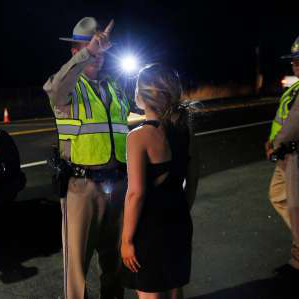 A bright graduate with a recent degree drank white wine and was driving home late at night. After 3:00 AM, two San Diego DUI officers were dispatched to a solo vehicle traffic collision with an unresponsive female in the driver seat and medical personnel responding. The roadway the collision took place on consisted of one lane of travel for westbound travel and one lane of travel for eastbound travel. The alleged DUI driver collided into a fence on the side. She was placed in an American Medical Response ambulance and the car towed with minor damage.
A bright graduate with a recent degree drank white wine and was driving home late at night. After 3:00 AM, two San Diego DUI officers were dispatched to a solo vehicle traffic collision with an unresponsive female in the driver seat and medical personnel responding. The roadway the collision took place on consisted of one lane of travel for westbound travel and one lane of travel for eastbound travel. The alleged DUI driver collided into a fence on the side. She was placed in an American Medical Response ambulance and the car towed with minor damage.
Once the medics on scene cleared the accused driver, the officers asked her to meet them by the front of their patrol vehicle. While she was escorted to the front of the vehicle, the officers observed she had an unsteady gait by swaying from side to side. They spoke with her regarding the traffic collision and observed signs and symptoms of alcohol intoxication including red and watery eyes, slow slurred speech, and the odor of an alcohol beverage emitting from her breath and person. The alleged DUI driver stated that she was the sole occupant before, during, and after the traffic collision.
Due to the signs and symptoms of alcohol intoxication, a series of field sobriety tests were performed. The first consisted of a horizontal gaze nystagmus, where the accused driver exhibited lack of smooth pursuit in both eyes. The officers observed distinct and sustained nystagmus at maximum deviation and nystagmus prior to the onset of 45 degrees in both eyes. She then swayed from left to right during the one leg stand test, and failed to touch the tip of her index finger to the tip of her nose on six of six attempts. The alleged DUI driver was slow and deliberate, exhibiting signs and symptoms for the officers to ask her to take a preliminary alcohol screen device, which she refused.
The officers formed the opinion the driver was under the influence of alcohol and unable to safely operate a motor vehicle, and placed her under arrest. After being transported to a women’s detention facility, the accused driver chose to do a breath test, displaying a .17% BAC.
While alcohol-related traffic collision incidents can result in severe consequences, the alleged DUI driver was able to receive minimal punishment in the San Diego Superior Court. The accused DUI driver had to only pay the minimum fine & assessments, do only three days of public service program, be on only three years of probation rather than five, and have an ignition interlock device for only six months rather than one to three years. As a bonus, the court accepted her smart attendance AA meetings instead of having to attend MADD. She’s not MADD about her good outcome.
